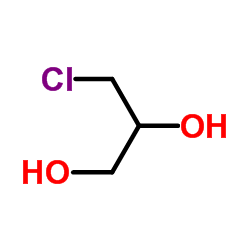3-Chloro-1,2-propanediol

3-Chloro-1,2-propanediol structure
|
Common Name | 3-Chloro-1,2-propanediol | ||
|---|---|---|---|---|
| CAS Number | 96-24-2 | Molecular Weight | 110.539 | |
| Density | 1.3±0.1 g/cm3 | Boiling Point | 213.0±0.0 °C at 760 mmHg | |
| Molecular Formula | C3H7ClO2 | Melting Point | -40ºC | |
| MSDS | Chinese USA | Flash Point | 113.3±21.8 °C | |
| Symbol |



GHS05, GHS06, GHS08 |
Signal Word | Danger | |
|
Mechanism of chemical activation of sodium chloride in the presence of amino acids.
Food Chem. 166 , 301-8, (2014) Sodium chloride has been shown to promote chlorination of glycerol during thermal processing. However, the detailed mechanism of this reaction is not well understood. Preliminary experiments have indicated that the reaction mixture should contain an amino aci... |
|
|
Exposure assessment of 3-monochloropropane-1, 2-diol esters from edible oils and fats in China.
Food Chem. Toxicol. 75 , 8-13, (2015) 3-monochoropropane-1, 2-diol (3-MCPD) esters from edible oils are considered to be a possible risk factor for adverse effects in human. In the present study, the exposure assessment of 3-MCPD esters to Chinese population was performed. A total of 143 edible o... |
|
|
Quantification of 3-MCPD and its mercapturic metabolite in human urine: validation of an LC-MS-MS method and its application in the general population.
Anal. Bioanal. Chem 407 , 4823-7, (2015) A new method for the simultaneous quantitative determination in human urine of 3-monochloropropane-1,2-diol (3-MCPD), a toxic food contaminant, and its metabolite, 2,3-dihydroxypropyl mercapturic acid (DHPMA), was developed and validated. After urine dilution... |
|
|
Formation of 3-monochloro-1,2-propanediol (3-MCPD) di- and monoesters from tristearoylglycerol (TSG) and the potential catalytic effect of Fe²⁺ and Fe³⁺.
J. Agric. Food Chem. 63(6) , 1839-48, (2015) This study investigated whether and how triacylglycerol (TAG) may serve as a precursor for 3-monochloro-1,2-propanediol (3-MCPD) fatty acid ester formation using tristearoylglycerol (TSG). TSG was reacted with inorganic chloride compounds including NaCl, KCl,... |
|
|
Complete detoxification of tris(1,3-dichloro-2-propyl) phosphate by mixed two bacteria, Sphingobium sp. strain TCM1 and Arthrobacter sp. strain PY1.
J. Biosci. Bioeng. 113(1) , 79-83, (2012) Tris(1,3-dichloro-2-propyl) phosphate (TDCPP), a flame retardant, is regarded as a potentially toxic and persistent environmental contaminant. We previously isolated a TDCPP-degrading bacterium, Sphingobium sp. strain TCM1, which, however, produced a toxic me... |
|
|
Proteomic analysis of 3-MCPD and 3-MCPD dipalmitate toxicity in rat testis.
Food Chem. Toxicol. 83 , 84-92, (2015) Thermal treatment of foodstuff containing fats and salt promotes the formation of 3-chloropropane-1,2-diol (3-MCPD) and its fatty acid esters. 3-MCPD-exposed rats develop testicular lesions and Leydig cell tumors. 3-MCPD and 3-MCPD ester toxicity is thought t... |
|
|
Passage of MHPG from plasma to CSF in a non-human primate.
Rev. Med. Chir. Soc. Med. Nat. Iasi. 115(4) , 1278-82, (2011) In experimental protocols with humans and non-human primates, cerebrospinal fluid (CSF) concentrations of 3-methoxy-4-hydroxyphenylethylene glycol (MHPG), the predominant end-product of norepinephrine metabolism in the mammalian central nervous system (CNS), ... |
|
|
Fatty acid esters of monochloropropanediol (MCPD) and glycidol in refined edible oils.
Food Addit. Contam. Part A. Chem. Anal. Control. Expo. Risk Assess. 30(1) , 46-51, (2013) Recently, fatty acid esters of monochloropropanediol (MCPD) and that of glycidol have been reported in refined edible oils. Since then a wealth of research has been published on the factors influencing the formation of these contaminants in foods. It can be n... |
|
|
Toxicological assessment of 3-chloropropane-1,2-diol and glycidol fatty acid esters in food.
Mol. Nutr. Food. Res. 55(4) , 509-21, (2011) Fatty acid esters of 3-chloropropane-1,2-diol (3-MCPD) and glycidol are a newly identified class of food process contaminants. They are widespread in refined vegetable oils and fats and have been detected in vegetable fat-containing products, including infant... |
|
|
An evaluation of the chick cardiomyocyte micromass system for identification of teratogens in a blind trial
Reprod. Toxicol. 28(4) , 503-10, (2009) The chick micromass culture system has advantages over the validated rat system – ready availability and non-culling of the donor parent – but needs to give comparable results. This study confirmed comparability and the ability to extend the system to cover c... |